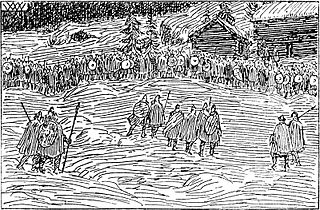Related Research Articles

Year 1161 (MCLXI) was a common year starting on Sunday of the Julian calendar.

Haakon VII was King of Norway from November 1905 until his death in September 1957.

Haakon IV Haakonsson, sometimes called Haakon the Old in contrast to his namesake son, was King of Norway from 1217 to 1263. His reign lasted for 46 years, longer than any Norwegian king since Harald Fairhair. Haakon was born into the troubled civil war era in Norway, but his reign eventually managed to put an end to the internal conflicts. At the start of his reign, during his minority, Earl Skule Bårdsson served as regent. As a king of the birkebeiner faction, Haakon defeated the uprising of the final bagler royal pretender, Sigurd Ribbung, in 1227. He put a definitive end to the civil war era when he had Skule Bårdsson killed in 1240, a year after he had himself proclaimed king in opposition to Haakon. Haakon thereafter formally appointed his own son as his co-regent.

Haakon V Magnusson was king of Norway from 1299 until 1319.
Inge Haraldsson was king of Norway from 1136 to 1161. Inge’s reign fell within the start of the period known in Norwegian history as the civil war era. He was never the sole ruler of the country. He is often known as Inge the Hunchback, because of his physical disability. However, this epithet does not appear in medieval sources.

Inge II was King of Norway from 1204 to 1217. His reign was within the later stages of the period known in Norwegian history as the age of civil wars. Inge was the king of the birkebeiner faction. The conclusion of the settlement of Kvitsøy with the bagler faction in 1208 led to peace for the last nine years of Inge’s reign, at the price of Inge and the birkebeiner recognising bagler rule over Viken.
Haakon Sigurdsson, also known as Haakon Herdebrei, was King of Norway from 1157 until 1162 during the Civil war era in Norway.
Guttorm Sigurdsson was the king of Norway from January to August 1204, during the Norwegian civil war era. As a grandson of King Sverre, he was proclaimed king by the Birkebeiner faction when he was just four years old. Although obviously not in control of the events surrounding him, Guttorm's accession to the throne under the effective regency of Haakon the Crazy led to renewed conflict between the Birkebeiner and the Bagler factions, the latter supported militarily by Valdemar II of Denmark.

The Bagli Party or Bagler was a faction or party during the Norwegian Civil Wars. The Bagler faction was made up principally of the Norwegian aristocracy, clergy and merchants.
Philip Simonsson was a Norwegian aristocrat and from 1207 to 1217 was the Bagler party pretender to the throne of Norway during the civil war era in Norway.

Skule Bårdsson or Duke Skule was a Norwegian nobleman and claimant to the royal throne against his son-in-law, King Haakon Haakonsson. Henrik Ibsen's play Kongs-Emnerne (1863) is about the dispute between Duke Skule and King Haakon.

The Fairhair dynasty was a family of kings founded by Harald I of Norway which united and ruled Norway with few interruptions from the latter half of the 9th century. In the traditional view, this lasted until 1387, however, many modern scholars view this rule as lasting only three generations, ending with Harald Greycloak in the late 10th century. The moniker "Fairhair dynasty" is a retrospective construction: in their lifetime what little traces there are refer to them consistently as "Ynglings".
Sigurd Erlingsson Ribbung was a Norwegian nobleman and pretender to the throne of Norway during the civil war era in Norway.

Inga Olafsdatter of Varteig was the mistress of King Haakon III of Norway and the mother of King Haakon IV of Norway.
Events in the year 1204 in Norway.
Events in the year 1217 in Norway.
Events in the year 1157 in Norway.
Events in the year 1147 in Norway.
The Last King is a 2016 Norwegian historical drama, directed by Nils Gaup. The story, inspired by true events, centers on the efforts of the Birkebeiner loyalists to protect the infant, Haakon Haakonsson, the heir to the Norwegian throne after the death of his father, King Haakon Sverresson. The film is set during the civil war era in Norway during the 13th-century.

The Battle of Oslo was fought outside of Oslo on the night of 3 February 1161 between Haakon II of Norway and Inge I of Norway during the civil war era in Norway. As the son of Ingiríðr Ragnvaldsdóttir and king Harald Gille, Inge had been named king of Norway after Gille was killed by Sigurd Slembe. His two half-brothers, Magnus and Sigurd, were also named kings around the same time, and the three ruled Norway. By 1157, Inge's brothers were both dead, and he was the sole remaining ruler of Norway. Haakon II, an illegitimate son of Gille, then contested Inge's rule, and at the Battle of Oslo Inge was killed. According to the Heimskringla, Inge had 4,800 men.
References
- ↑ Brathetland, Bente Opheim. "Inge 1 Haraldsson Krokrygg". In Helle, Knut (ed.). Norsk biografisk leksikon (in Norwegian). Oslo: Kunnskapsforlaget. Retrieved 22 July 2015.